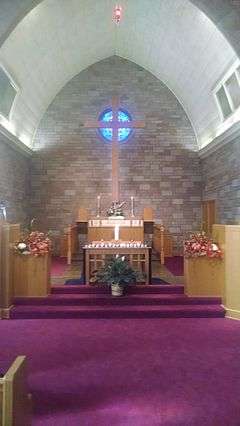Totensonntag
Totensonntag (Sunday of the Dead), also called Ewigkeitssonntag (Eternity Sunday) or Totenfest, is a Northern German and Dutch Protestant religious holiday commemorating the dead. It falls on the last Sunday before the First of the Sundays of Advent (i.e. always on or between Nov. 20 and Nov. 26), and it is the last Sunday of the liturgical year in the German Evangelical Church and the Protestantse Kerk in The Netherlands. Where it is marked, such as in Berlin, it replaces All Souls' Day (Nov. 2).
| Totensonntag | |
|---|---|
 A congregation of the United States-based denomination Evangelical and Reformed Church observing Totenfest by lighting votive candles in memory of the faithful departed | |
| Also called | Ewigkeitssonntag Totenfest |
| Observed by | Lutherans & Reformed in Germany |
| Significance | Remembrance of the Faithful Departed |
| Observances | church services, praying for the dead, lighting votive candles, visiting cemeteries and graveyards[1] |
| Related to | Allhallowtide (All Hallows' Eve, All Saints' Day, All Souls' Day); Blue Christmas; Advent; Thursday of the Dead; Reformation Day; Remembrance Sunday |
History
In 1816, King Frederick William III of Prussia made his cabinet pass a decree that stated all Lutheran churches in the areas under Prussian rule had to observe the last Sunday before Advent as a "general celebration in memorial of the deceased".[2] Other Lutheran churches in the remainder of Germany followed, eventually, as well.
In the United States, some Protestant churches celebrate this service of remembrance as Totenfest.[3].
Special protection
Totensonntag is a protected holiday in all German states. The holiday laws of all federal states, with the exception of Hamburg, have special provisions, classifying Totensonntag either as a memorial day or a "silent day" which implies special restrictions.[4] Depending on the state, music may not be played in public venues or only at certain hours, and dancing is forbidden as well (German: Tanzverbot).
See also
- Stir-up Sunday
- Day of the Dead
- Thursday of the Dead
- All Souls' Day
- Festival of the Dead
- Battle of Totensonntag
References
- Black, Monica (10 May 2010). Death in Berlin: From Weimar to Divided Germany. Cambridge University Press. p. 34. ISBN 9780521118514.
Totensonntag was an occasion for remembering and praying for the dead and was celebrated by attending church services and making cemetery pilgrimages.
- RGG, 3. Aufl.; Band VI Spalte 957
- "Totenfest." "Archived copy" (PDF). Archived from the original (PDF) on 2008-05-17. Retrieved 2013-11-20.CS1 maint: archived copy as title (link), accessed 2013-11-20
- "§ 2(1)III Gesetz über Sonntage, Feiertage, Gedenktage und Trauertage vom 16. Oktober 1953" (PDF). Retrieved 2009-11-21.
Further reading
- Bieritz, Karl-Heinrich (2005). Das Kirchenjahr. Feste, Gedenk- und Feiertage in Geschichte und Gegenwart. Beck’sche Reihe (in German). 447 (Fourth ed.). München: Beck. ISBN 3-406-47585-X.
